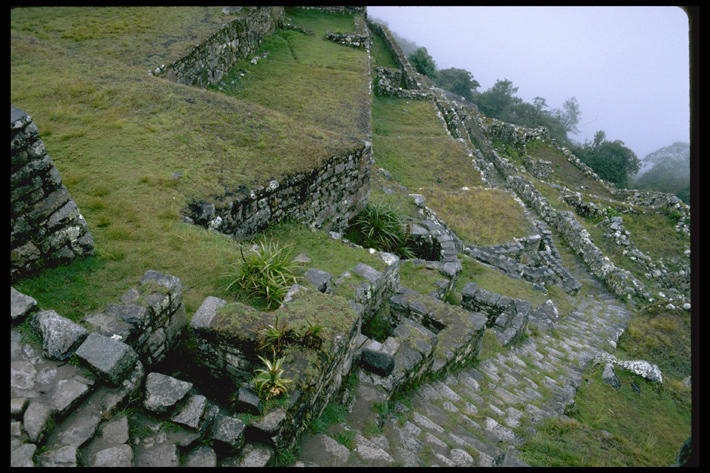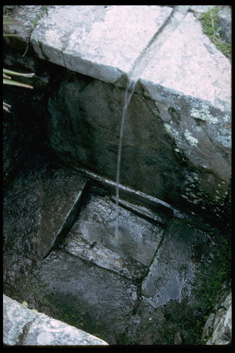Latin America
Showing Original Post only (View all)Machu Picchu's Stairway of Fountains [View all]
Only just saw this for the first time:
By JULIAN SMITH
January/February 2013

(Courtesy Tamara L. Bray)The square chambers next to a staircase at the Inca city of Machu Picchu are part
of an ingenious network of 16 fountains.
One of the most spectacular examples of Inca hydraulic engineering is the "Stairway of Fountains," built sometime after 1450 at the city of Machu Picchu. The fountains supplied the city's inhabitants with clean, fresh water. The first challenge the Inca faced was how to bring water from a pair of rain-fed springs almost half a mile away from the first fountain. At the main spring, Inca engineers built a 48-foot long permeable wall that concentrated the seeping water into a stone-lined canal. The canal also collected water from a second, smaller spring. Water flowed to the city through the canal, which averaged five inches wide and five inches deep, and had an average grade of about 3 percent. Hydraulic engineer Ken Wright calculates the system could carry up to 80 gallons per minute—twice as much water as the springs' typical peak flow—to prevent overflows.

(Courtesy Tamara L. Bray) Each
fountain produced a stream of water
shaped to fill a water jug.
The canal passed under the city's outer wall, through the agricultural zone, and under another wall into the residential zone, where it flowed through a series of 16 fountains. Each fountain had a spout designed to shape a jet of water that was the perfect size for filling an aryballo, the clay water jug of the ancient Andes. The fountains were linked by stone channels that formed a 180-foot-long cascade of water with a total vertical drop of 65 feet. The first fountain was next to the emperor Pachacuti's residence, allowing him first access to the water. All the fountains, including Pachacuti's, were publicly accessible except the last one, which was located inside the Temple of the Condor.
The result was a controlled, dependable public water supply that protected the hillside architecture from erosion. "Nothing like it exists," says hydraulic engineer Charles Ortloff, "in an urban setting at other royal residence sites or at other Inca settlements."
https://www.archaeology.org/issues/59-1301/76-sidebars/394-machu-picchu-inca-hydraulic-engineering
~ ~ ~
The Water Temple of Inca-Caranqui
Hydraulic engineering was the key to winning the hearts and minds of a conquered people
By JULIAN SMITH
January/February 2013
Tamara Bray of Wayne State University walks through a municipal lot in a suburb of the colonial city of Ibarra, in the Andean highlands of northern Ecuador. At 7,550 feet on the northern slope of Imbabura Volcano, the equatorial sun has an intensity that burns through the occasional cool breeze. Chickens peck in the dirt and we can hear children playing at a school nearby. As we walk through the lot, which is now an archaeological site called Inca-Caranqui, Bray explains that the local people knew this was an ancient settlement long before the first archaeological surveys in the late 1990s. Just across the street stand two walls—one 130 feet long and the other 165—that were built by the Inca. One wall has traces of three trapezoidal doorways with remnants of plaster and pigments.
Ecuadorian archaeologist José Echeverría leads us through the site, down a winding path that follows the low outlines of partially excavated walls. He explains that, in 2006, he was helping clear debris left over from a brickmaking operation when he uncovered some Inca masonry at the east end of the site, which turned out to be part of a large ceremonial pool about 33 by 55 feet in size. It was dug to a depth of four to five feet below the modern ground level and was surrounded by walls about three feet high. The walls and floor were made of finely cut and fitted stone.
Bray and Echeverría believe the pool may date to a period in the early 1500s, shortly after the Inca ruler Huayna Capac had concluded a 10-year war of conquest against the local people, the Caranqui. Legend has it that Huayna Capac had every adult male Caranqui executed. Their bodies were thrown into a lake known today as Yahuarcocha, or the “Lake of Blood,” on Ibarra’s northeast edge. Spanish chronicler Pedro Cieza de León estimated the conflict left 20,000 to 50,000 Caranqui dead.
Bray and Echeverría think that in the aftermath of that bloodshed, the Inca built the pool as part of a construction project that was meant to demonstrate their power to their new Caranqui subjects. The ceremonial pool would have represented a considerable investment of wealth and labor by the Inca. It also would have showed their skill as engineers by bringing water from as far as five and a half miles away and demonstrated their mastery over a resource with powerful religious symbolism.
More:
https://www.archaeology.org/issues/59-1301/61-features/324-ibarra-andes-huayna-capac-atahualpa